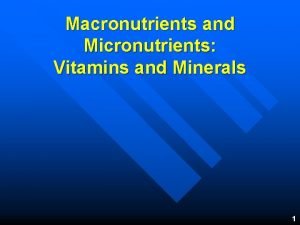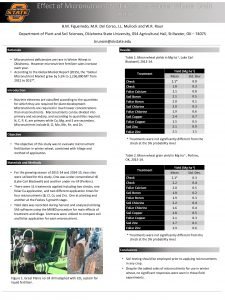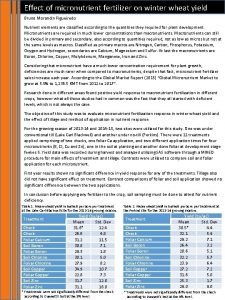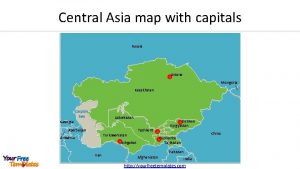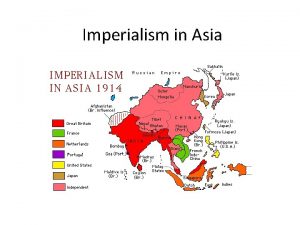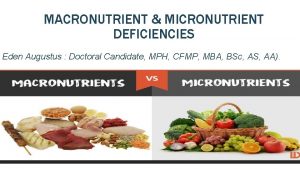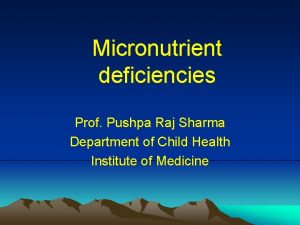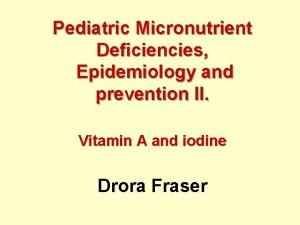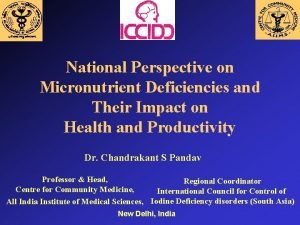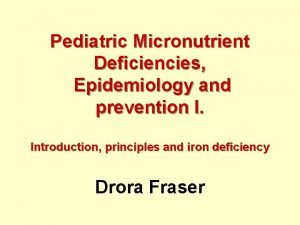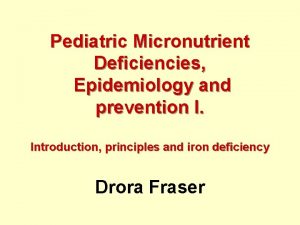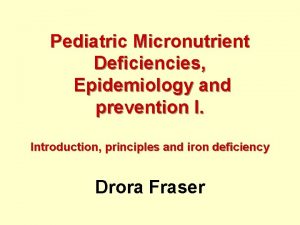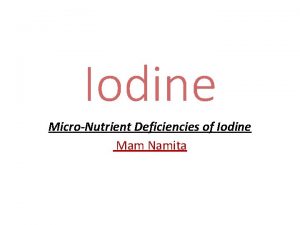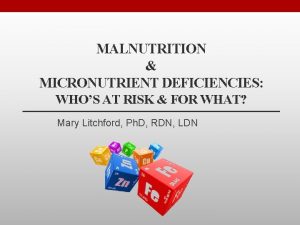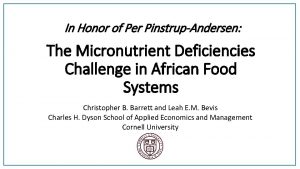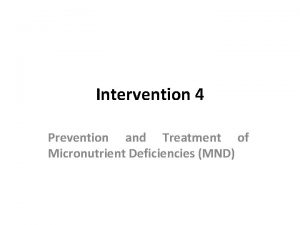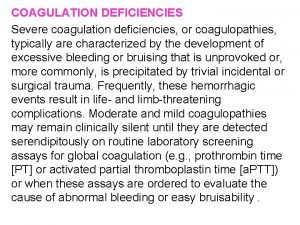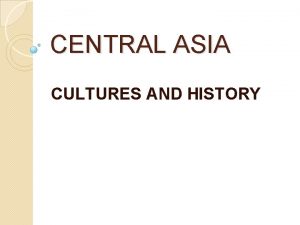Micronutrient Deficiencies New Challenges for Central Asia Nune






























- Slides: 30

Micro-nutrient Deficiencies: New Challenges for Central Asia Nune Mangasaryan, UNICEF CARK, Workshop on Policies on Food Fortification, and Monitoring and Evaluation, 7 -9 April 2003, Bishkek, Kyrgyz Republic 1

Current Estimates of Iodine Deficiency in CIS 2

DHS 1995 59 % women 81% children DHS Experience DHS 1997 50 % women 73% children DHS 1999 36 % women 36% children DHS 2000 47 % women 36% children DHS 1996 72 % women 81% children Tadjikistan: Women - > 60% Children - 69% U 3) (MOH) 3

Vit. A deficiency in CARK 4

5

Causes of Death Among Pre-School Children in Non-Industrialised Countries, 2000 Malnutrition 60% 6 Ref. ; WHO 2002

Causes of Death Among Pre-School Children in Non-Industrialised Countries, 2000 Malnutrition 60% Vitamin A Deficiency Increases risk of mortality with 23 % 7 Ref. ; WHO 2002

Strategies to review Public Health actions Population coverage Supplementation Dietary diversification Food fortification 8 time

1997 CARK Anemia Prevention and Control Programme Strategy Education for dietary change Flour fortification Weekly supplementation 6 -24 months Adolescents and childbearing age women Pregnant women Research agenda of key studies and monitoring activities Programme linkages IMCI Nut. Act. Plan BF Reprod. Health. 9

Strategic planning: APC • There are serious levels of anaemia in all the CARK countries. • These high prevalences will cause developmental problems in children most affected, pregnancy-related outcome problems in women, etc • The experience gained starting 1990 s in APC and certain achievements and accomplishments (in all strategic directions) provide a good basis for further expansion and scaling up with significant outcome within 3 -4 years. 10

Fortification: Flour fortification This is a real opportunity and should be aggressively pursued over the next few years. • The experience of fortification started recently and lessons learned provide a good basis for further expansion and scaling up with significant outcome within 3 -4 years. All efforts have to be applied to call for government, partners, donors attention to support the initiative. • Like all the approaches this will not be the total answer, but will help elevate the national average intakes of iron (and other micronutrients) and allow resources and attention to be given in a more targeted way to those still deficient. 11

Main interventions for wheat flour fortification • Enforce National Legislation and regulations on flour fortification (including prohibition of export of non fortified flour) • To enforce communication strategy • Develop monitoring system of iron fortification in grain mills. Further support of monitoring system 12

Main interventions for wheat flour fortification • Initiate mass production of fortified flour at all large mills in countries, thus ensuring access to fortified flour for at least 90% of women and children • Procurement of equipment and consumables to maintain sustainability of fortification process at the pilot mills and to extend experience to the large mills • Technical consultancy and support, including experience exchange from the Countries reaching flour fortification during the first stages of real implementation of flour fortification. 13

Supplementation • Continue Iron supplementation with review of target group, strengthening of all interventions proposed at desk review until fortification is taken to the scale • Improve management and organisation, supply distribution, build capacities, IEC with strong monitoring component at all levels • Review preventive supplementation and treatment guidelines 14

Conditions Required for an Effective Salt Iodization Programme èTo reach USI within a year or two and be sustainable: 4 Commitment of the Government and salt industry 4 Need of partnership 4 Legislation 4 Working enforcement mechanisms 4 Reliable surveillance system for monitoring quality control and quality Assurance è To have a large population coverage, including the population groups the most at risk 4 Monitoring of household coverage 4 Strengthen Communication component è To correct iodine deficiency by ensuring adequate iodine intake 4 Assessment of iodine status (UIE) every 3 -4 years 15

Steps to reach USI in CARK è To ensure USI: 4 Support to salt producer: capacities for salt iodisation, marketing, testing, involvement in policy and decision making process 4 Three-level surveillance system: ò Reliable surveillance system for monitoring quality control and quality Assurance ò Market monitoring ò Monitoring of household coverage, with attention to population groups the most at risk 16

Steps to reach USI in CARK è To be sustainable 4 Commitment of the Government and salt industry 4 Need of partnership 4 Legislation - to adopt and introduce mechanisms for effective enforcement 4 Consumer education è To correct iodine deficiency by ensuring adequate iodine intake 4 Assessment of iodine status (UIE) every 3 -4 years 17

Solutions through Partnerships in the country ï Government agencies ï Associations of producers ï NGOs ï Consumer organisations ï Media ï International organisations ï Scientific groups 18

Communications • National communication plans: to review, enrich, and operationalise • Ownership and commitment of government: advocacy has to be reached through advocacy efforts : politicians, media. • More tools for decision makers: costeffectiveness and other economic implications 19

The economic costs of undernutrition are high: productivity losses 20

Relative Cost Effectiveness of Micronutrient Interventions Source: UNICEF/UNU/WHO/MI, 1999 21

Iron deficiency costs around 0. 9% of the GDP Over $US 350 millions to the CARK countries Kazakhstan $142. 2 million; Kyrgyzstan $11. 7 million; Uzbekistan $159. 3 million; Turkmenistan $28. 8 million; Tajikistan $17 million. 22

Monitoring and evaluation 1. Production: Quality assurance and quality control 2. Market 3. Households and schools 4. Import: customs 23

Strategic planning ! Government high-level Leadership to play a role of coordination between different agencies: MOH/SES, Mo. Ed, Industry, Agriculture, NGOs ! National plans need further development and enrichment to include recommendations for USI, UFF, and successful elimination of VAD ! The government support, ownership, and investment for the process 24

Measures to Correct Vitamin A Deficiency Supplementation Food Fortification Dietary Diversification Public Health Measures All approaches are complementary and should not be used in isolation 25

Supplementation: prevention èAdvantages å Easy to implement å Fast improvement of vitamin A status å å å Easy to target vulnerable populations Low-cost (2 cents per capsule) Easy to do - minimal training and equipment required èConstraints å Short term approach å Distribution every 6 months å Requires heavy logistics 26

Food Fortification Globally a growing interest for food fortification èHas turned out to be more feasible than expected in non industrialised countries (eg mass fortification in Central America, Morocco, Zambia) 27

Food Fortification Advantages å Wide coverage å Easy to implement å No active participation of population å Cheap Constraints å å Entire population is exposed The target groups - pre school age children and pregnant women - may not be reached Requires centralised food industry Requires effective surveillance system (quality control, biological impact) 28

Dietary Diversification Advantages è Long term approach to control VAD è Relies on èAvailability of vitamin A rich food (fruits, vegetables and animal products) Constraints è Small scale projects èLimited population coverage 29

Complementary Public Health Measures è Integrated management to control infections diseases (IMCI) è Immunisation (EPI) è Safe motherhood interventions è Improve malnutrition and other micronutrient deficiencies èIron deficiency èIodine Deficiency è Promotion of breast feeding è Improve water and sanitation è Poverty alleviation programmes 30
 Satish nune
Satish nune Fictionalism adler
Fictionalism adler Safeguarding tendencies withdrawal
Safeguarding tendencies withdrawal Conjunctivitius
Conjunctivitius +winter +wheat +micronutrient
+winter +wheat +micronutrient +winter +wheat +micronutrient
+winter +wheat +micronutrient Swana countries map
Swana countries map Astana russia map
Astana russia map Conqueror of central asia
Conqueror of central asia The new nation faces challenges
The new nation faces challenges British imperialism in asia
British imperialism in asia Fspos vägledning för kontinuitetshantering
Fspos vägledning för kontinuitetshantering Typiska drag för en novell
Typiska drag för en novell Nationell inriktning för artificiell intelligens
Nationell inriktning för artificiell intelligens Returpilarna
Returpilarna Varför kallas perioden 1918-1939 för mellankrigstiden
Varför kallas perioden 1918-1939 för mellankrigstiden En lathund för arbete med kontinuitetshantering
En lathund för arbete med kontinuitetshantering Personalliggare bygg undantag
Personalliggare bygg undantag Tidbok för yrkesförare
Tidbok för yrkesförare A gastrica
A gastrica Densitet vatten
Densitet vatten Datorkunskap för nybörjare
Datorkunskap för nybörjare Tack för att ni lyssnade bild
Tack för att ni lyssnade bild Hur skriver man en tes
Hur skriver man en tes Autokratiskt ledarskap
Autokratiskt ledarskap Nyckelkompetenser för livslångt lärande
Nyckelkompetenser för livslångt lärande Påbyggnader för flakfordon
Påbyggnader för flakfordon Kraft per area
Kraft per area Svenskt ramverk för digital samverkan
Svenskt ramverk för digital samverkan Jag har nigit för nymånens skära
Jag har nigit för nymånens skära Presentera för publik crossboss
Presentera för publik crossboss



